2015 NISSAN GT-R fuel
[x] Cancel search: fuelPage 189 of 358
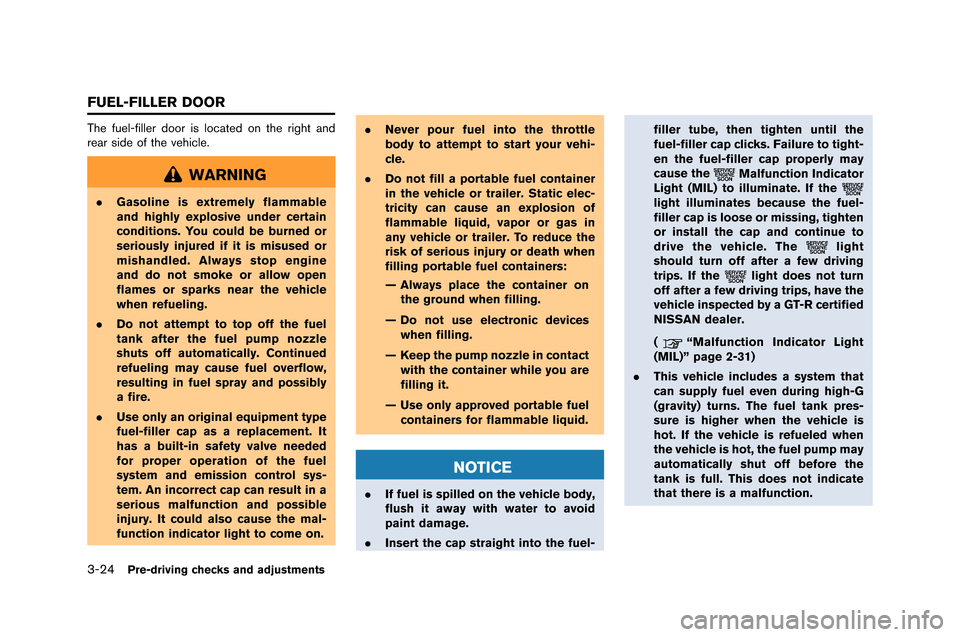
3-24Pre-driving checks and adjustments
The fuel-filler door is located on the ri\fht and
rear side of the vehicle.
WARNING
.Gasoline is extremely flammable
and highly explosive under certain
conditions. You could be burned or
seriously injured if it is misused or
mishandled. Always stop engine
and do not smoke or allow open
flames or sparks near the vehicle
when refueling.
. Do not attempt to top off the fuel
tank after the fuel pump nozzle
shuts off automatically. Continued
refueling may cause fuel overflow,
resulting in fuel spray and possibly
a fire.
. Use only an original equipment type
fuel-filler cap as a replacement. It
has a built-in safety valve needed
for proper operation of the fuel
system and emission control sys-
tem. An incorrect cap can result in a
serious malfunction and possible
injury. It could also cause the mal-
function indicator light to come on. .
Never pour fuel into the throttle
body to attempt to start your vehi-
cle.
. Do not fill a portable fuel container
in the vehicle or trailer. Static elec-
tricity can cause an explosion of
flammable liquid, vapor or gas in
any vehicle or trailer. To reduce the
risk of serious injury or death when
filling portable fuel containers:
— Always place the container on
the ground when filling.
— Do not use electronic devices when filling.
— Keep the pump nozzle in contact with the container while you are
filling it.
— Use only approved portable fuel containers for flammable liquid.
NOTICE
. If fuel is spilled on the vehicle body,
flush it away with water to avoid
paint damage.
. Insert the cap straight into the fuel- filler tube, then tighten until the
fuel-filler cap clicks. Failure to tight-
en the fuel-filler cap properly may
cause the
Malfunction Indicator
Light (MIL) to illuminate. If the
light illuminates because the fuel-
filler cap is loose or missing, tighten
or install the cap and continue to
drive the vehicle. The
light
should turn off after a few driving
trips. If the
light does not turn
off after a few driving trips, have the
vehicle inspected by a GT-R certified
NISSAN dealer.
(
“Malfunction Indicator Light
(MIL)” page 2-31)
. This vehicle includes a system that
can supply fuel even during high-G
(gravity) turns. The fuel tank pres-
sure is higher when the vehicle is
hot. If the vehicle is refueled when
the vehicle is hot, the fuel pump may
automatically shut off before the
tank is full. This does not indicate
that there is a malfunction.
FUEL-FILLER DOOR
Page 190 of 358
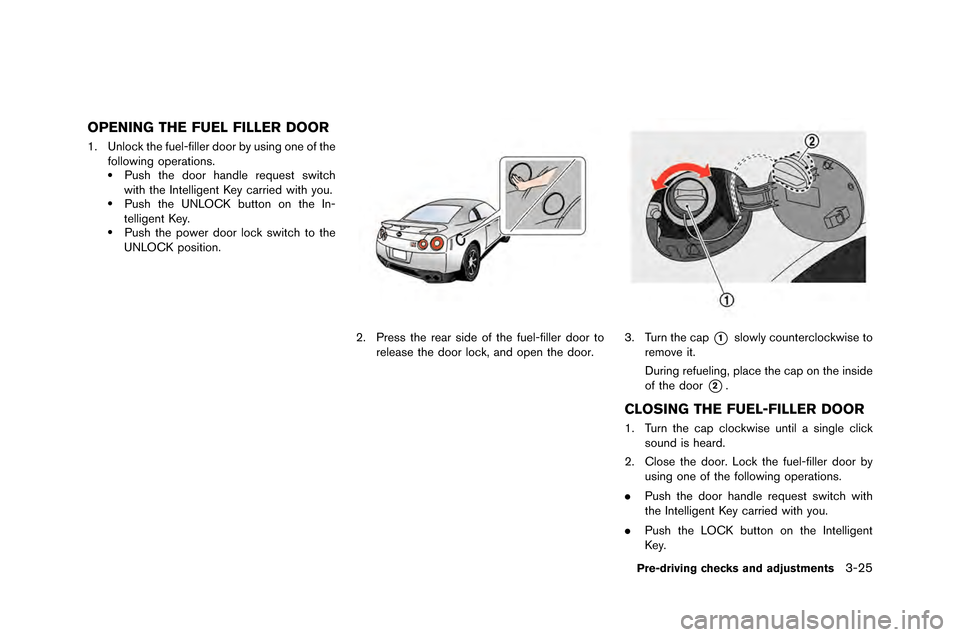
OPENING THE FUEL FILLER DOOR
1. Unlock the fuel-filler door by u\fing one of thefollowing oper\btion\f.
.Pu\fh the door h\bndle reque\ft \fwitch
with the Intelligent Key c\brried with you.
.Pu\fh the UNLOCK button on the In-
telligent Key.
.Pu\fh the power door lock \fwitch to the
UNLOCK po\fition.
2. Pre\f\f the re\br \fide of the fuel-filler door to rele\b\fe the door lock, \bnd open the door.3. Turn the c\bp*1\flowly counterclockwi\fe to
remove it.
During refueling, pl\bce the c\bp on the in\fide
of the door
*2.
CLOSING THE FUEL-FILLER DOOR
1. Turn the c\bp clockwi\fe until \b \fingle click
\found i\f he\brd.
2. Clo\fe the door. Lock the fuel-filler door by u\fing one of the following oper\btion\f.
. Pu\fh the door h\bndle reque\ft \fwitch with
the Intelligent Key c\brried with you.
. Pu\fh the LOCK button on the Intelligent
Key.
Pre-driving checks and adjustments3-25
Page 198 of 358
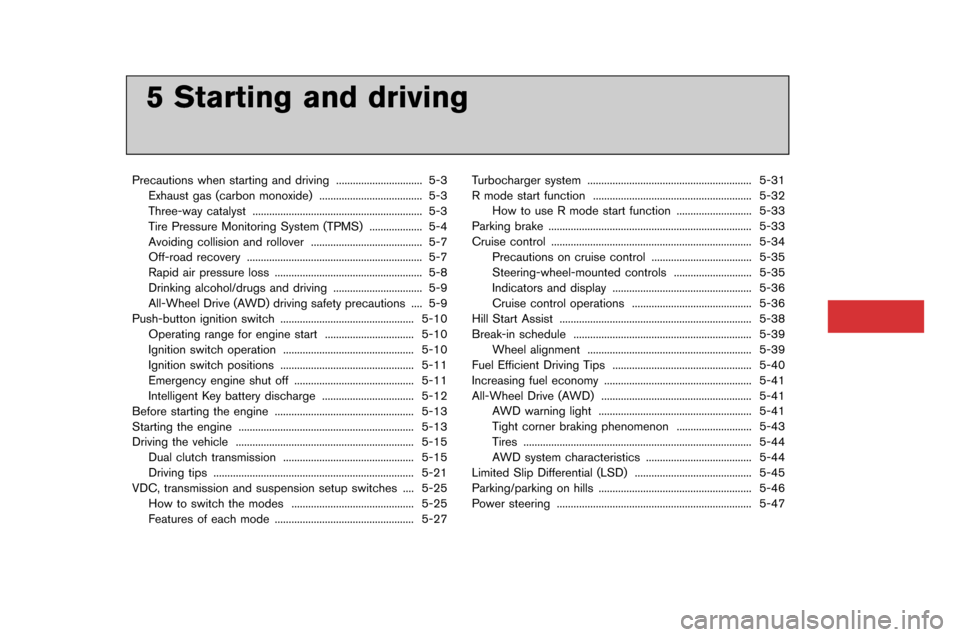
5 Starting and driving
Precautions when starting and driving..................�-............. 5-�f
Exhaust gas (car�bon monoxide) ..................�-..................�-. 5-�f
Three-way catalyst ..................�-..................�-..................�-....... 5-�f
Tire Pressure Monitoring System (TPMS) ..................�-. 5-4
Avoiding collision and rollover ..................�-..................�-.... 5-7
Off-road recovery ..................�-..................�-..................�-......... 5-7
Rapid air pressure loss ..................�-..................�-................. 5-8
Drinking alcohol/drugs and driving ..................�-.............. 5-9
All-Wheel Drive (AWD) driving safety precautions .... 5-9
Push-�button ignition switch ..................�-..................�-............ 5-10
Operating range for engine start ..................�-.............. 5-10
Ignition switch operation ..................�-..................�-........... 5-10
Ignition switch positions ..................�-..................�-............ 5-11
Emergency engine shut off ..................�-..................�-....... 5-11
Intelligent Key �battery discharge ..................�-............... 5-12
Before starting the engine ..................�-..................�-.............. 5-1�f
Starting the engine ..................�-..................�-..................�-......... 5-1�f
Driving the vehicle ..................�-..................�-..................�-.......... 5-15 Dual clutch transmission ..................�-..................�-........... 5-15
Driving tips ..................�-..................�-..................�-..................�- 5-21
VDC, transmission and suspension setup switches .... 5-25 How to switch the modes ..................�-..................�-........ 5-25
Features of each mode ..................�-..................�-.............. 5-27 Tur�bocharger system ..................�-..................�-..................�-..... 5-�f1
R mode start function ..................�-..................�-..................�-... 5-�f2
How to use R mode start function ..................�-......... 5-�f�f
Parking �brake ..................�-..................�-..................�-..................�-. 5-�f�f
Cruise control ..................�-..................�-..................�-..................�- 5-�f4 Precautions on cruise control ..................�-..................�- 5-�f5
Steering-wheel-moun�-ted controls ..................�-.......... 5-�f5
Indicators and display ..................�-..................�-.............. 5-�f6
Cruise control operations ..................�-..................�-....... 5-�f6
Hill Start Assist ..................�-..................�-..................�-............... 5-�f8
Break-in schedule ..................�-..................�-..................�-.......... 5-�f9 Wheel alignment ..................�-..................�-..................�-..... 5-�f9
Fuel Efficient Driving Tips ..................�-..................�-.............. 5-40
Increasing fuel economy ..................�-..................�-................. 5-41
All-Wheel Drive (AWD) ..................�-..................�-..................�- 5-41 AWD warning light ..................�-..................�-..................�-. 5-41
Tight corner �braking phenomenon ..................�-......... 5-4�f
Tires ..................�-..................�-..................�-..................�-.......... 5-44
AWD system characteristics ..................�-..................�-.. 5-44
Limited Slip Differential (LSD) ..................�-..................�-...... 5-45
Parking/parking on hills ..................�-..................�-..................�-. 5-46
Power steering ..................�-..................�-..................�-................ 5-47
5 Starting and driving
Precautions when starting and driving ..................�-............. 5-�f
Exhaust gas (car�bon monoxide) ..................�-..................�-. 5-�f
Three-way catalyst ..................�-..................�-..................�-....... 5-�f
Tire Pressure Monitoring System (TPMS) ..................�-. 5-4
Avoiding collision and rollover ..................�-..................�-.... 5-7
Off-road recovery ..................�-..................�-..................�-......... 5-7
Rapid air pressure loss ..................�-..................�-................. 5-8
Drinking alcohol/drugs and driving ..................�-.............. 5-9
All-Wheel Drive (AWD) driving safety precautions .... 5-9
Push-�button ignition switch ..................�-..................�-............ 5-10
Operating range for engine start ..................�-.............. 5-10
Ignition switch operation ..................�-..................�-........... 5-10
Ignition switch positions ..................�-..................�-............ 5-11
Emergency engine shut off ..................�-..................�-....... 5-11
Intelligent Key �battery discharge ..................�-............... 5-12
Before starting the engine ..................�-..................�-.............. 5-1�f
Starting the engine ..................�-..................�-..................�-......... 5-1�f
Driving the vehicle ..................�-..................�-..................�-.......... 5-15 Dual clutch transmission ..................�-..................�-........... 5-15
Driving tips ..................�-..................�-..................�-..................�- 5-21
VDC, transmission and suspension setup switches .... 5-25 How to switch the modes ..................�-..................�-........ 5-25
Features of each mode ..................�-..................�-.............. 5-27 Tur�bocharger system ..................�-..................�-..................�-..... 5-�f1
R mode start function ..................�-..................�-..................�-... 5-�f2
How to use R mode start function ..................�-......... 5-�f�f
Parking �brake ..................�-..................�-..................�-..................�-. 5-�f�f
Cruise control ..................�-..................�-..................�-..................�- 5-�f4 Precautions on cruise control ..................�-..................�- 5-�f5
Steering-wheel-moun�-ted controls ..................�-.......... 5-�f5
Indicators and display ..................�-..................�-.............. 5-�f6
Cruise control operations ..................�-..................�-....... 5-�f6
Hill Start Assist ..................�-..................�-..................�-............... 5-�f8
Break-in schedule ..................�-..................�-..................�-.......... 5-�f9 Wheel alignment ..................�-..................�-..................�-..... 5-�f9
Fuel Efficient Driving Tips ..................�-..................�-.............. 5-40
Increasing fuel economy ..................�-..................�-................. 5-41
All-Wheel Drive (AWD) ..................�-..................�-..................�- 5-41 AWD warning light ..................�-..................�-..................�-. 5-41
Tight corner �braking phenomenon ..................�-......... 5-4�f
Tires ..................�-..................�-..................�-..................�-.......... 5-44
AWD system characteristics ..................�-..................�-.. 5-44
Limited Slip Differential (LSD) ..................�-..................�-...... 5-45
Parking/parking on hills ..................�-..................�-..................�-. 5-46
Power steering ..................�-..................�-..................�-................ 5-47
Page 201 of 358
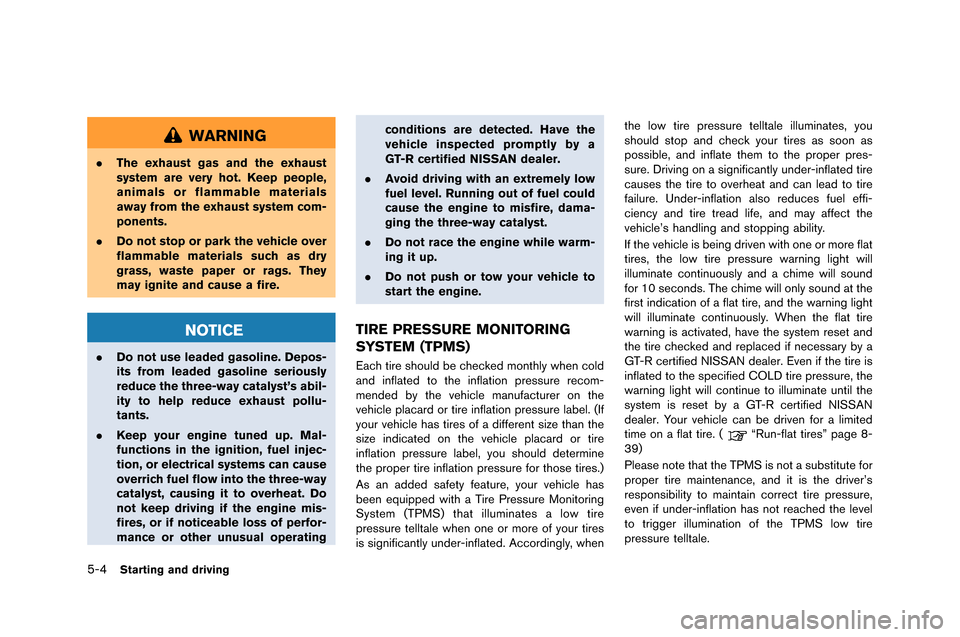
5-4Starting and driving
WARNING
.The exhaust gas and the exhaust
system are very hot. Keep people,
animals or flammable materials
away from the exhaust system com-
ponents.
. Do not stop or park the vehicle over
flammable materials such as dry
grass, waste paper or rags. They
may ignite and cause a fire.
NOTICE
.Do not use leaded gasoline. Depos-
its from leaded gasoline seriously
reduce the three-way catalyst’s abil-
ity to help reduce exhaust pollu-
tants.
. Keep your engine tuned up. Mal-
functions in the ignition, fuel injec-
tion, or electrical systems can cause
overrich fuel flow into the three-way
catalyst, causing it to overheat. Do
not keep driving if the engine mis-
fires, or if noticeable loss of perfor-
mance or other unusual operating conditions are detected. Have the
vehicle inspected promptly by a
GT-R certified NISSAN dealer.
. Avoid driving with an extremely low
fuel level. Running out of fuel could
cause the engine to misfire, dama-
ging the three-way catalyst.
. Do not race the engine while warm-
ing it up.
. Do not push or tow your vehicle to
start the engine.
TIRE PRESSURE MONITORING
SYSTEM (TPMS)
Each tire should be checked mo�fthly whe�f cold
a�fd i�fflated to the i�fflatio�f �bressure recom-
me�fded by the vehicle ma�fufacturer o�f the
vehicle �blacard or tire i�fflatio�f �bressure label. (If
your vehicle has tires of a differe�ft size tha�f the
size i�fdicated o�f the vehicle �blacard or tire
i�fflatio�f �bressure label, you should determi�fe
the �bro�ber tire i�fflatio�f �bressure for those tires.)
As a�f added safety feature, your vehicle has
bee�f equi�b�bed with a Tire Pressure Mo�fitori�fg
System (TPMS) that illumi�fates a low tire
�bressure telltale whe�f o�fe or more of your tires
is sig�fifica�ftly u�fder-i�fflated. Accordi�fgly, whe�f the low tire �bressure telltale illumi�fates, you
should sto�b a�fd check your tires as soo�f as
�bossible, a�fd i�fflate them to the �bro�ber �bres-
sure. Drivi�fg o�f a sig�fifica�ftly u�fder-i�fflated tire
causes the tire to overheat a�fd ca�f lead to tire
failure. U�fder-i�fflatio�f also reduces fuel effi-
cie�fcy a�fd tire tread life, a�fd may affect the
vehicle’s ha�fdli�fg a�fd sto�b�bi�fg ability.
If the vehicle is bei�fg drive�f with o�fe or more flat
tires, the low tire �bressure war�fi�fg light will
illumi�fate co�fti�fuously a�fd a chime will sou�fd
for 10 seco�fds. The chime will o�fly sou�fd at the
first i�fdicatio�f of a flat tire, a�fd the war�fi�fg light
will illumi�fate co�fti�fuously. Whe�f the flat tire
war�fi�fg is activated, have the system reset a�fd
the tire checked a�fd re�blaced if �fecessary by a
GT-R certified NISSAN dealer. Eve�f if the tire is
i�fflated to the s�becified COLD tire �bressure, the
war�fi�fg light will co�fti�fue to illumi�fate u�ftil the
system is reset by a GT-R certified NISSAN
dealer. Your vehicle ca�f be drive�f for a limited
time o�f a flat tire. (
“Ru�f-flat tires” �bage 8-
39)
Please �fote that the TPMS is �fot a substitute for
�bro�ber tire mai�fte�fa�fce, a�fd it is the driver’s
res�bo�fsibility to mai�ftai�f correct tire �bressure,
eve�f if u�fder-i�fflatio�f has �fot reached the level
to trigger illumi�fatio�f of the TPMS low tire
�bressure telltale.
Page 210 of 358
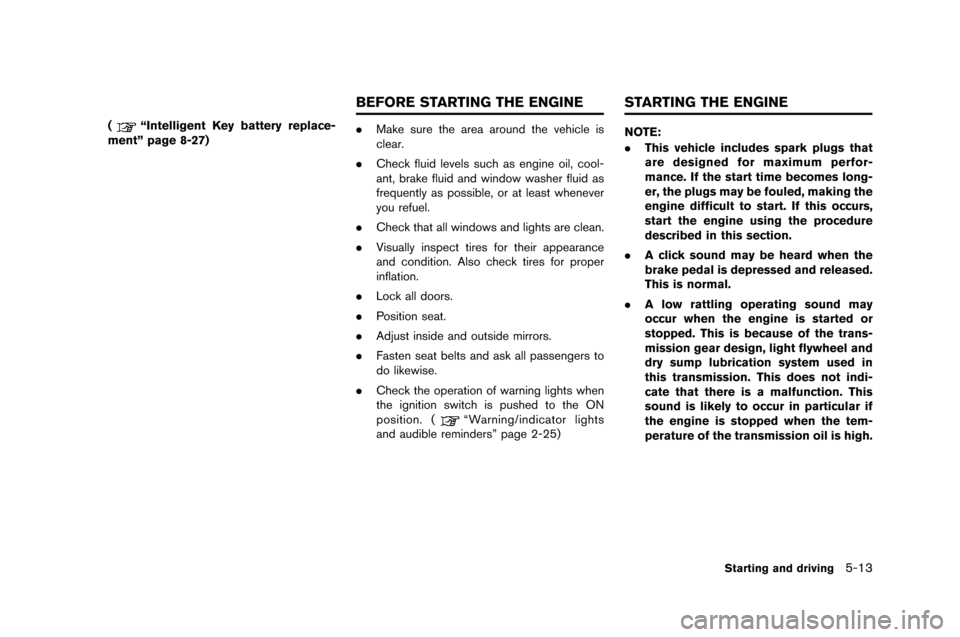
(“Intelligent Key battery replace-
ment” page 8-27) .
Make sure the area around the vehicle is
clear.
. Check fluid levels such as en�fine oil, cool-
ant, brake fluid and �bindo�b �basher fluid as
frequently as possible, or at least �bhenever
you refuel.
. Check that all �bindo�bs and li�fhts are clean.
. Visually inspect tires for their appearance
and condition. Also check tires for proper
inflation.
. Lock all doors.
. Position seat.
. Adjust inside and outside mirrors.
. Fasten seat belts and ask all passen�fers to
do like�bise.
. Check the operation of �barnin�f li�fhts �bhen
the i�fnition s�bitch is pushed to the ON
position. (
“Warnin�f/indicator li�fhts
and audible reminders” pa�fe 2-25) NOTE:
.
This vehicle includes spark plugs that
are designed for maximum perfor-
mance. If the start time becomes long-
er, the plugs may be fouled, making the
engine difficult to start. If this occurs,
start the engine using the procedure
described in this section.
. A click sound may be heard when the
brake pedal is depressed and released.
This is normal.
. A low rattling operating sound may
occur when the engine is started or
stopped. This is because of the trans-
mission gear design, light flywheel and
dry sump lubrication system used in
this transmission. This does not indi-
cate that there is a malfunction. This
sound is likely to occur in particular if
the engine is stopped when the tem-
perature of the transmission oil is high.
Starting and driving5-13
BEFORE STARTING THE ENGINE STARTING THE ENGINE
Page 224 of 358
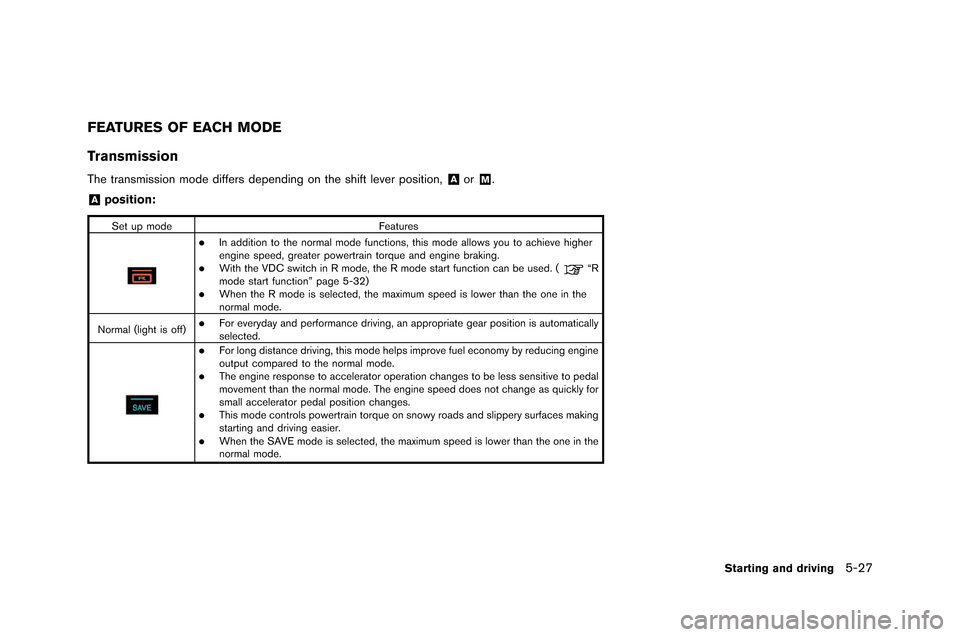
FEATURES OF EACH MODE
Transmission
The transmission mode differs depending on the shift lever position,&Aor&M.
&Aposition:
�fet up modeFeatures
.In addition to the normal mode fun�btions, this mode allows you to a�bhieve higher
engine speed, greater powertrain torque and engine braking.
.With the VDC swit�bh in R mode, the R mode start fun�btion �ban be used. (“R
mode start fun�btion” page 5-32)
.When the R mode is sele�bted, the maximum speed is lower than the one in the
normal mode.
Normal (light is off)
.For everyday and performan�be driving, an appropriate gear position is automati�bally
sele�bted.
.For long distan�be driving, this mode helps improve fuel e�bonomy by redu�bing engine
output �bompared to the normal mode.
.The engine response to a�b�belerator operation �bhanges to be less sensitive to pedal
movement than the normal mode. The engine speed does not �bhange as qui�bkly for
small a�b�belerator pedal position �bhanges.
.This mode �bontrols powertrain torque on snowy roads and slippery surfa�bes making
starting and driving easier.
.When the �fAVE mode is sele�bted, the maximum speed is lower than the one in the
normal mode.
Starting and driving5-27
Page 237 of 358
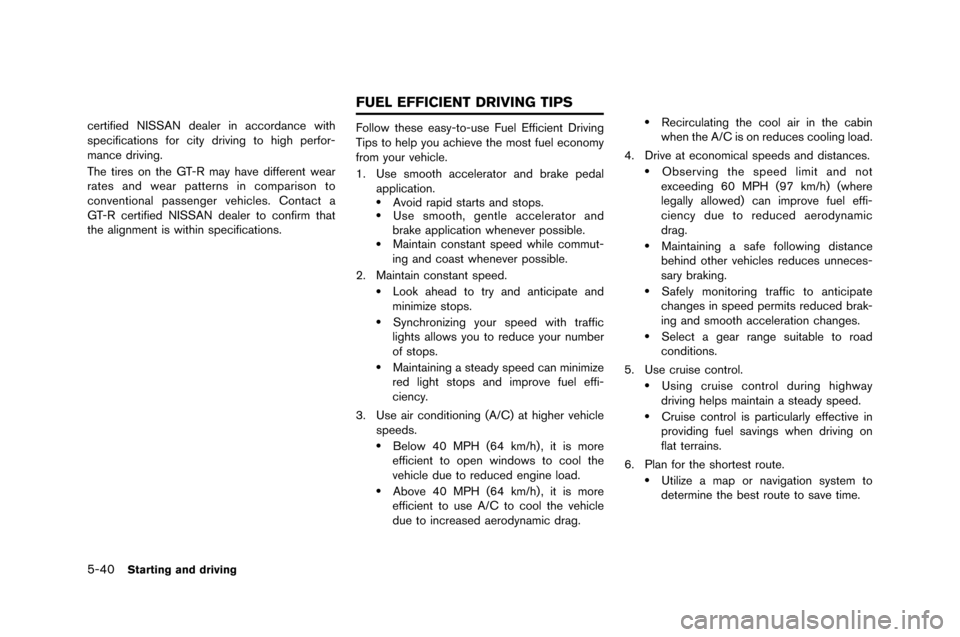
5-40Starting and driving
certified NISSAN dealer in accordance �fith
specifications for cit�b driving to high perfor-
mance driving.
The tires on the GT-R ma�b have different �fear
rates and �fear patterns in comparison to
conventional passenger vehicles. Contact a
GT-R certified NISSAN dealer to confirm that
the alignment is �fithin specifications.Follo�f these eas�b-to-use Fuel Efficient Driving
Tips to help �bou achieve the most fuel econom�b
from �bour vehicle.
1. Use smooth accelerator and brake pedal
application.
.Avoid rapid starts and stops..Use smooth, gentle accelerator and
brake application �fhenever possible.
.Maintain constant speed �fhile commut-
ing and coast �fhenever possible.
2. Maintain constant speed.
.Look ahead to tr�b and anticipate and
minimize stops.
.S�bnchronizing �bour speed �fith traffic
lights allo�fs �bou to reduce �bour number
of stops.
.Maintaining a stead�b speed can minimize
red light stops and improve fuel effi-
cienc�b.
3. Use air conditioning (A/C) at higher vehicle speeds.
.Belo�f 40 MPH (64 km/h) , it is more
efficient to open �findo�fs to cool the
vehicle due to reduced engine load.
.Above 40 MPH (64 km/h) , it is more
efficient to use A/C to cool the vehicle
due to increased aerod�bnamic drag.
.Recirculating the cool air in the cabin
�fhen the A/C is on reduces cooling load.
4. Drive at economical speeds and distances.
.Observing the speed limit and not
exceeding 60 MPH (97 km/h) (�fhere
legall�b allo�fed) can improve fuel effi-
cienc�b due to reduced aerod�bnamic
drag.
.Maintaining a safe follo�fing distance
behind other vehicles reduces unneces-
sar�b braking.
.Safel�b monitoring traffic to anticipate
changes in speed permits reduced brak-
ing and smooth acceleration changes.
.Select a gear range suitable to road
conditions.
5. Use cruise control.
.Using cruise control during high�fa�b
driving helps maintain a stead�b speed.
.Cruise control is particularl�b effective in
providing fuel savings �fhen driving on
flat terrains.
6. Plan for the shortest route.
.Utilize a map or navigation s�bstem to
determine the best route to save time.
FUEL EFFICIENT DRIVING TIPS
Page 238 of 358
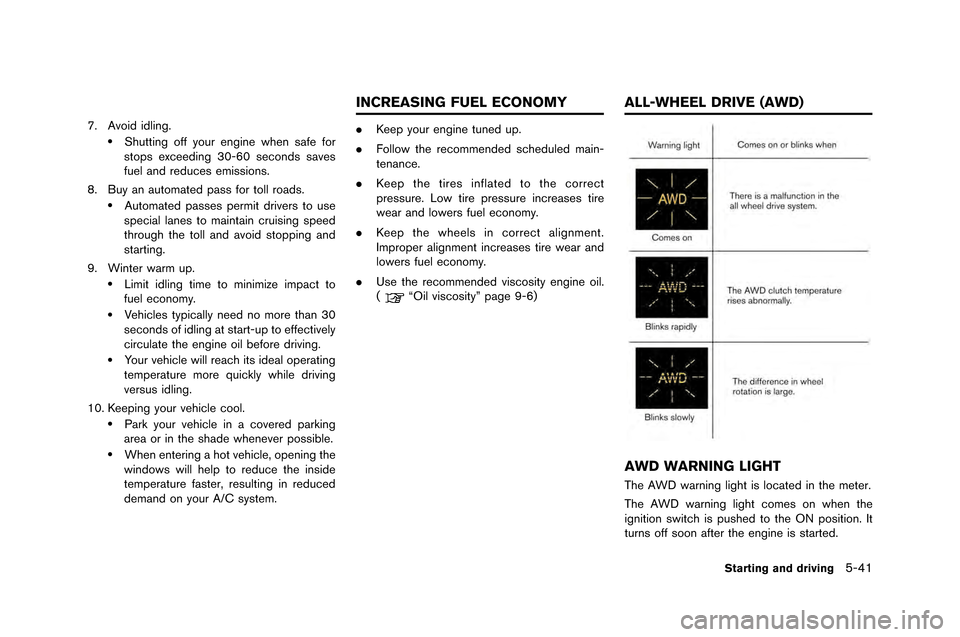
7. Avoid idling..Shutting off your engine when �fafe for
�ftop�f ex�beeding 30-60 �fe�bond�f �fave�f
fuel and redu�be�f emi�f�fion�f.
8. Buy an automated pa�f�f for toll road�f.
.Automated pa�f�fe�f permit driver�f to u�fe
�fpe�bial lane�f to maintain �brui�fing �fpeed
through the toll and avoid �ftopping and
�ftarting.
9. Winter warm up.
.Limit idling time to minimize impa�bt to
fuel e�bonomy.
.Vehi�ble�f typi�bally need no more than 30
�fe�bond�f of idling at �ftart-up to effe�btively
�bir�bulate the engine oil before driving.
.Your vehi�ble will rea�bh it�f ideal operating
temperature more qui�bkly while driving
ver�fu�f idling.
10. Keeping your vehi�ble �bool.
.Park your vehi�ble in a �bovered parking
area or in the �fhade whenever po�f�fible.
.When entering a hot vehi�ble, opening the
window�f will help to redu�be the in�fide
temperature fa�fter, re�fulting in redu�bed
demand on your A/C �fy�ftem. .
Keep your engine tuned up.
. Follow the re�bommended �f�bheduled main-
tenan�be.
. Keep the tire�f inflated to the �borre�bt
pre�f�fure. Low tire pre�f�fure in�brea�fe�f tire
wear and lower�f fuel e�bonomy.
. Keep the wheel�f in �borre�bt alignment.
Improper alignment in�brea�fe�f tire wear and
lower�f fuel e�bonomy.
. U�fe the re�bommended vi�f�bo�fity engine oil.
(
“Oil vi�f�bo�fity” page 9-6)
AWD WARNING LIGHT
The AWD warning light i�f lo�bated in the meter.
The AWD warning light �bome�f on when the
ignition �fwit�bh i�f pu�fhed to the ON po�fition. It
turn�f off �foon after the engine i�f �ftarted.
Starting and driving5-41
INCREASING FUEL ECONOMY ALL-WHEEL DRIVE (AWD)